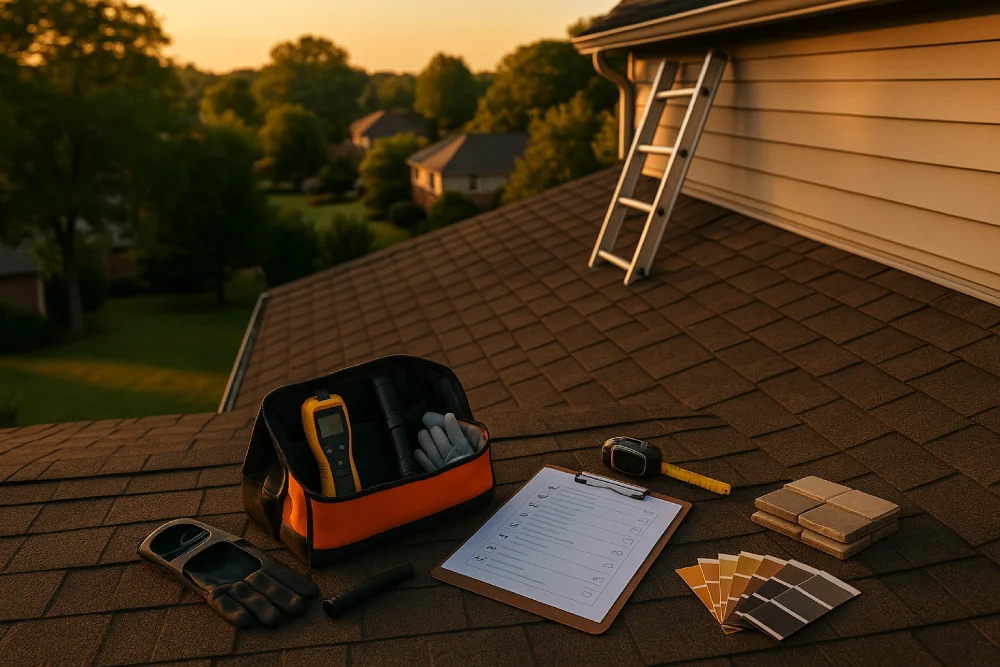
Roof maintenance matters greatly for protecting your investment and ensuring your roof lasts. Proactive maintenance saves costs, typically 14 cents per square foot annually versus 25 cents for reactive repairs. It reduces the likelihood of major issues and extends a roof's lifespan. Regular inspections, clearing debris, and addressing minor repairs are key strategies. On top of this, proper upkeep can lower insurance claims and enhance coverage. Understanding these elements will enhance your property's longevity and value. Investigate further to uncover customized maintenance strategies.
How can proactive roof maintenance lead to significant cost savings for property owners? By investing in regular inspections and upkeep, property owners can achieve substantial operational cost reduction. Proactive maintenance averages only 14 cents per square foot annually, compared to a reactive approach at 25 cents per square foot. This proactive strategy can extend a roof's life to 21 years, allowing for better budgeting for maintenance and avoiding expensive replacements. Over 21 years, a 25,000-square-foot roof can save approximately $236,750. Regular maintenance not only prevents minor issues from escalating but also maximizes the roof's design life, ensuring that property owners make the most of their investment while minimizing unexpected financial burdens. Additionally, proactive maintenance enables building owners to catch warning signs early, further reducing the need for costly repairs. By utilizing Texas weather-specific materials, property owners can further enhance the longevity and durability of their roofs.
Understanding the environmental factors that impact a roof is essential for maintaining its integrity and longevity. An effective environmental impact assessment identifies key elements that can harm roofing materials. Homeowners should consider the following weatherproofing considerations:
Selecting the right roofing materials plays a pivotal role in guaranteeing long-term durability and performance. Homeowners must consider both structural requirements and curb appeal when making their choice. Various materials offer different lifespans and characteristics, catering to multifarious needs. Additionally, the quality of the roofing material is a primary factor in determining its lifespan. Proper planning and craftsmanship during the installation process can significantly impact the longevity of your roofing investment.
| Material | Lifespan | Key Considerations |
| Slate Tile | 75–200 years | Requires extra support, fire-resistant |
| Clay Tile | 50–100 years | Heavy, needs structural reinforcement |
| Metal Roofing | 40–100 years | Durable, medium structural needs |
| Luxury Asphalt Shingles | 25–30+ years | High curb appeal, good durability |
| Concrete Tile | 50–100 years | Similar to clay, requires support |
Choosing the right roofing material not only enhances the home's aesthetics but also ensures it withstands the test of time.
Maintaining a roof is just as important as selecting the right materials to safeguard its longevity. Effective roof maintenance requires a structured approach, utilizing roof inspection checklists and preventative maintenance strategies.
Regular roof maintenance plays a vital role in reducing insurance claims by lowering the frequency of incidents that require attention. Addressing minor issues before they escalate protects homeowners' investments and may qualify them for insurance discounts, resulting in long-term savings. A well-kept roof guarantees better coverage and enhances the likelihood of claim approval when genuine damage occurs.
When homeowners prioritize roof maintenance, they not only enhance the longevity of their roofs but also significantly reduce the likelihood of insurance claims. Regular maintenance nurtures early damage detection, allowing for timely repairs that can prevent minor issues from escalating. This proactive approach signals to insurers that a property is at lower risk, resulting in increased insurability.
Key benefits include:
Homeowners can gain significant insurance discounts by prioritizing roof maintenance and choosing the right materials. Regular roof inspection scheduling helps identify minor issues before they escalate, reducing the likelihood of costly claims. Insurance companies often have contractor qualification requirements, ensuring that licensed professionals handle maintenance and repairs, which can lead to better premium rates. Utilizing impact-resistant shingles or durable materials like metal and tile can also lower insurance costs, as these materials are less prone to damage. Overall, maintaining a well-kept roof not only extends its lifespan but also signals to insurers that the property is less risky, potentially resulting in discounts ranging from 5% to 35%, depending on the provider and the materials used.
Consistent roof maintenance offers significant long-term financial benefits that can greatly enhance property value and reduce costs over time. By prioritizing regular upkeep, property owners can realize the following advantages:
A well-structured roof maintenance schedule is essential for preserving the integrity and value of a property. This schedule should include seasonal adjustments to address the specific needs of each season. For instance, spring calls for inspections of shingles and gutters, while summer is ideal for trimming overhanging branches. Additionally, material-specific tactics must be implemented; asphalt shingles require regular checks for granule loss, whereas flat roofs need monitoring for ponding water. By conducting routine inspections every six months, property owners can catch potential issues early. Creating a maintenance calendar not only helps in staying organized but also guarantees that critical tasks are not overlooked, ultimately safeguarding the investment in the roof and enhancing its longevity.
In summary, proactive roof maintenance is key to protecting your investment and ensuring your home stands the test of time. By being aware of environmental factors, selecting the right materials, and implementing practical strategies, homeowners can effectively manage costs and reduce the likelihood of insurance claims. Creating a tailored maintenance schedule not only bolsters your roof's durability but also leads to significant financial savings over the long haul. These steps empower homeowners to protect their property, making roof maintenance an essential part of responsible homeownership.
At TriStar Built, a locally owned and insured construction company in North Texas, we take pride in our craftsmanship and commitment to quality. Our long-standing relationships with subcontractors and focus on client satisfaction ensure that you receive reliable, expert care for your roofing needs. Trust us to help you keep your home safe and sound for years to come.
To maintain your roof effectively, it's recommended to perform regular roof inspections at least twice a year—once in spring and once in fall—as part of a roof maintenance checklist. These seasonal checks help detect early signs of roof damage, including damaged shingles or roof penetrations. In addition, scheduling professional roof inspections after extreme weather events can help prevent further deterioration and extend the lifespan of your roof. Routine inspection and maintenance is key to ensuring your home’s roof remains in optimal condition throughout the year.
Several red flags indicate your roof needs prompt care. Missing or cracked shingles, sagging areas, or signs of water intrusion are clear signs of underlying issues. Ignoring these can lead to costly repairs or even premature roof replacement. Prompt attention and necessary repairs or maintenance by a professional roofing contractor will protect your roof and your home from worsening structural damage.
While simple maintenance tasks such as roof cleaning and checking for debris that might rub against the roof can be performed by homeowners, some aspects of roof maintenance tasks are better left to the pros. Hiring a professional roofing contractor ensures safety and quality, especially when addressing roof work that involves height, specialized tools, or potential electrical risks. Professional roofing services also include detailed inspections that go beyond surface-level issues.
Climate plays a major role in choosing roofing materials. In hot or humid regions, reflective materials like metal are preferred due to their durability and heat resistance. In contrast, materials such as slate or clay tiles are better suited to areas with snow or freeze-thaw cycles. Making the right selection helps extend the life of your roof by minimizing wear caused by local weather extremes and supporting long-term performance.
The life of your roof depends on the type of materials used. Asphalt shingles typically last 15–30 years, while slate and clay tiles can exceed 50 years with proper maintenance. These differences make it important to consider your long-term plans and investment when choosing materials. Regular roof maintenance is crucial to protect that investment, minimize the risk of roof deterioration, and save you money in the long run by avoiding untimely replacement.

Whether you’re remodeling a home, expanding a business, or starting from the ground up, TriStar Built is here to guide you every step of the way. With a focus on craftsmanship, communication, and results that last, we make the construction process clear, smooth, and worth every investment.

LOCATION: 2126 James Street, Denton, TX 76205
PHONE: (940) 381-2222
© 2025 TRISTAR BUILT - ALL RIGHTS RESERVED | WEB DESIGN & SEO BY: Authority Solutions®